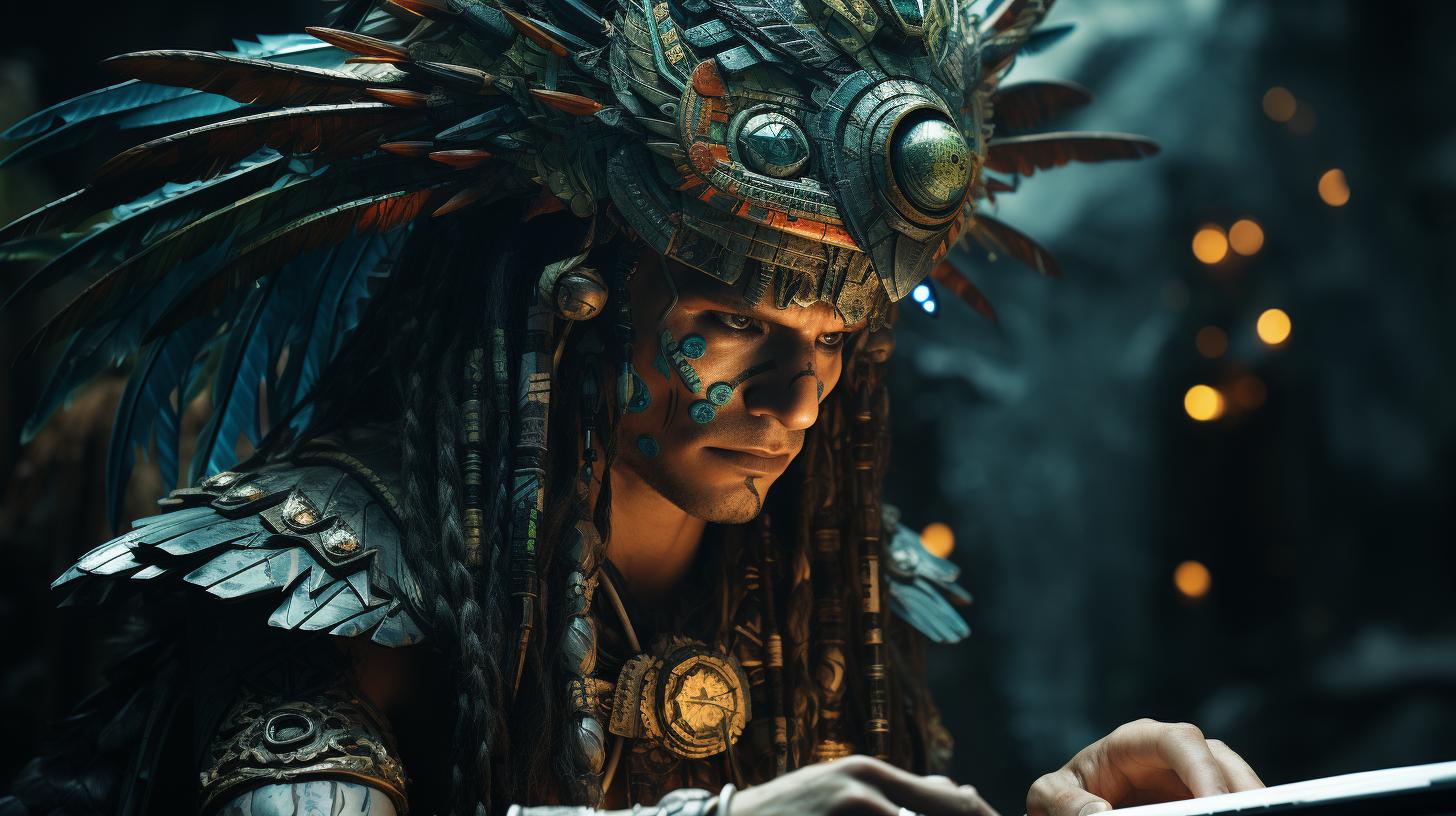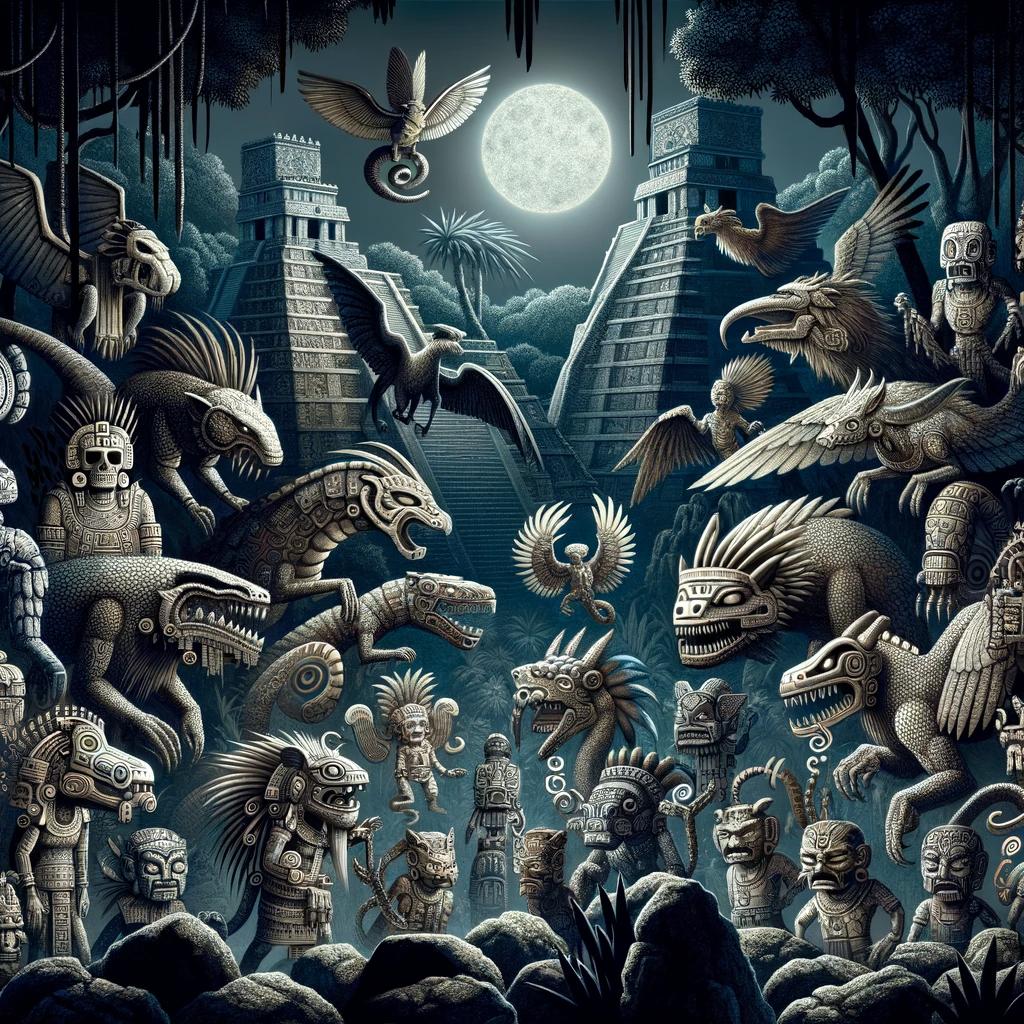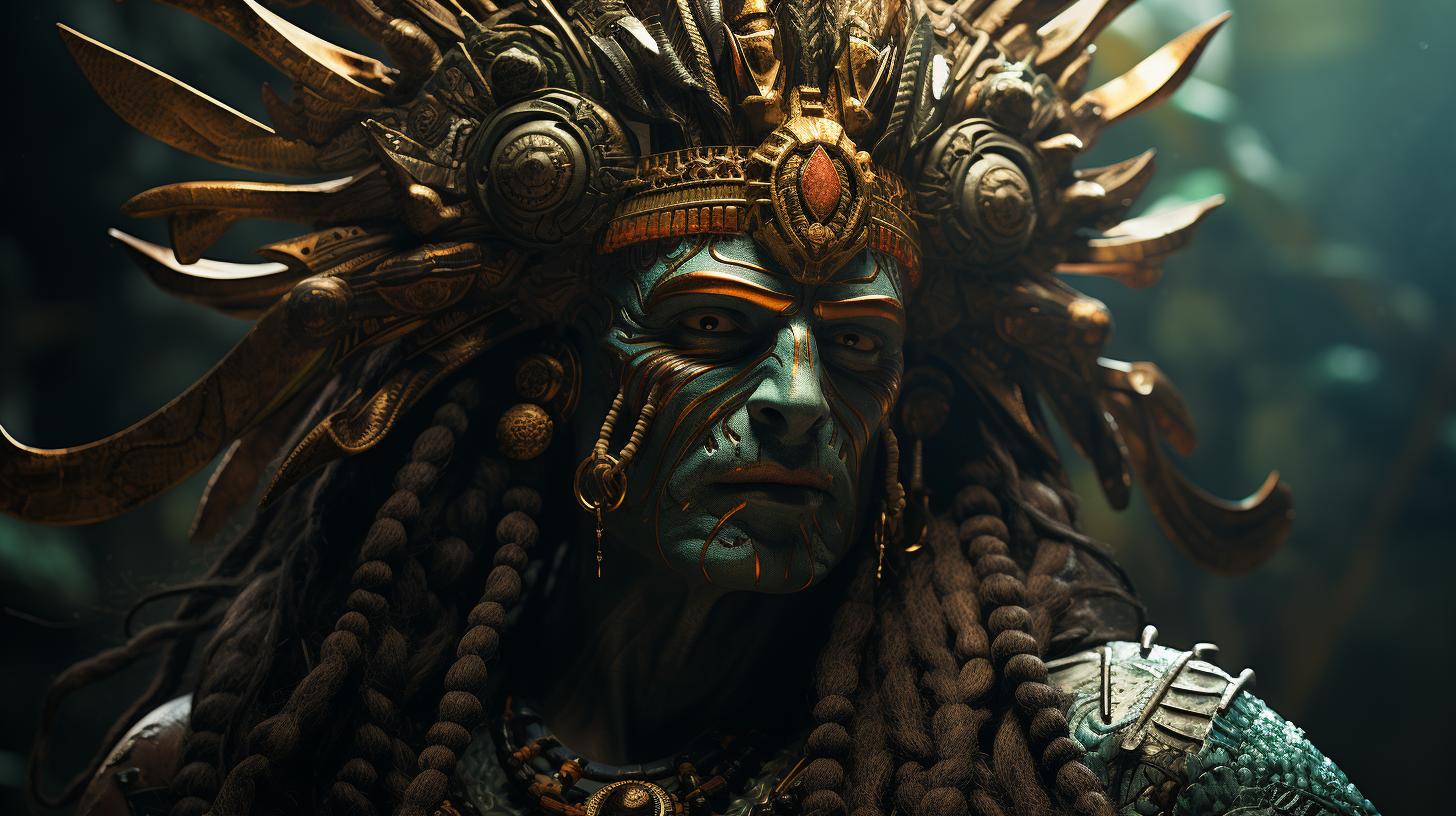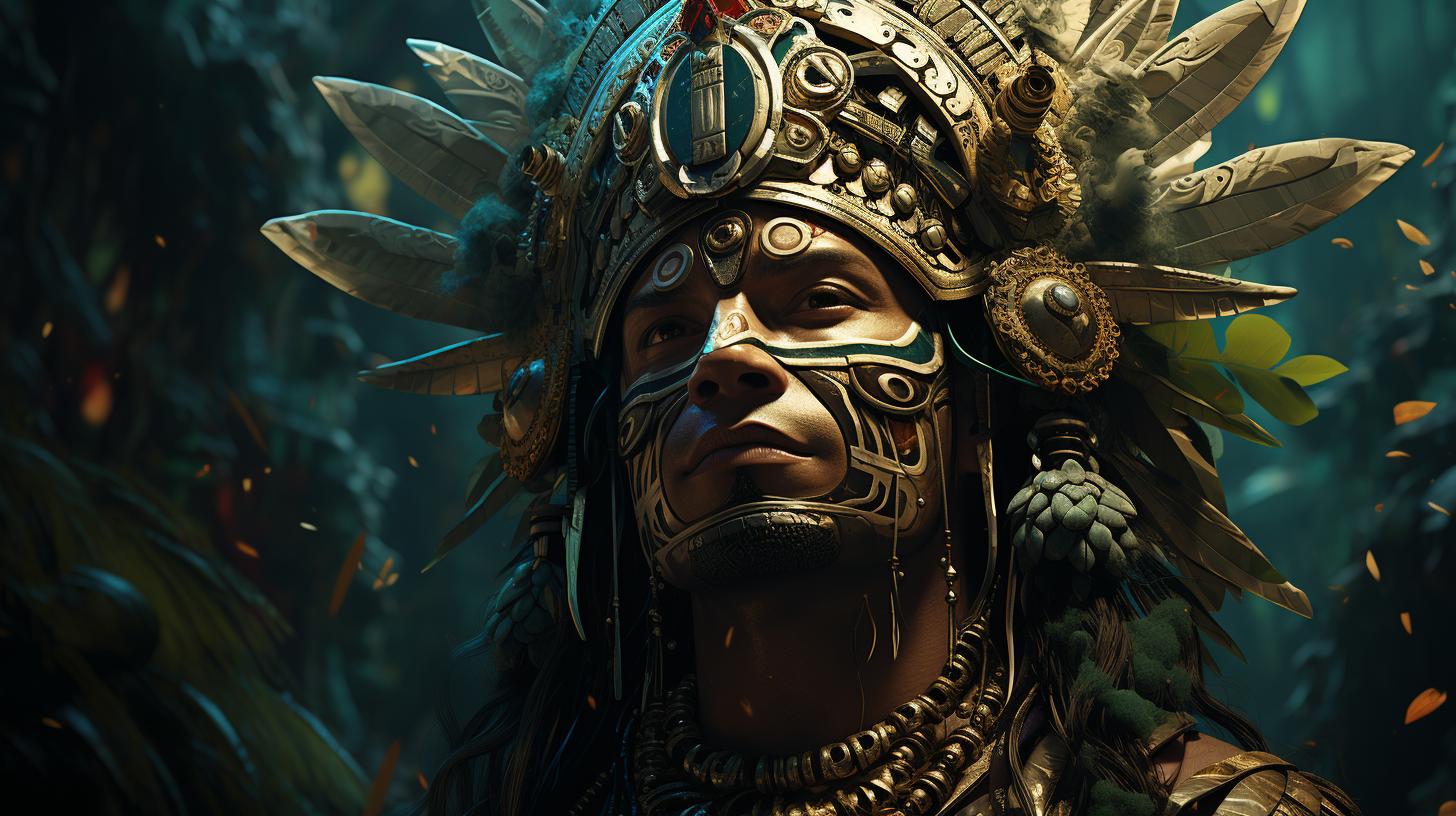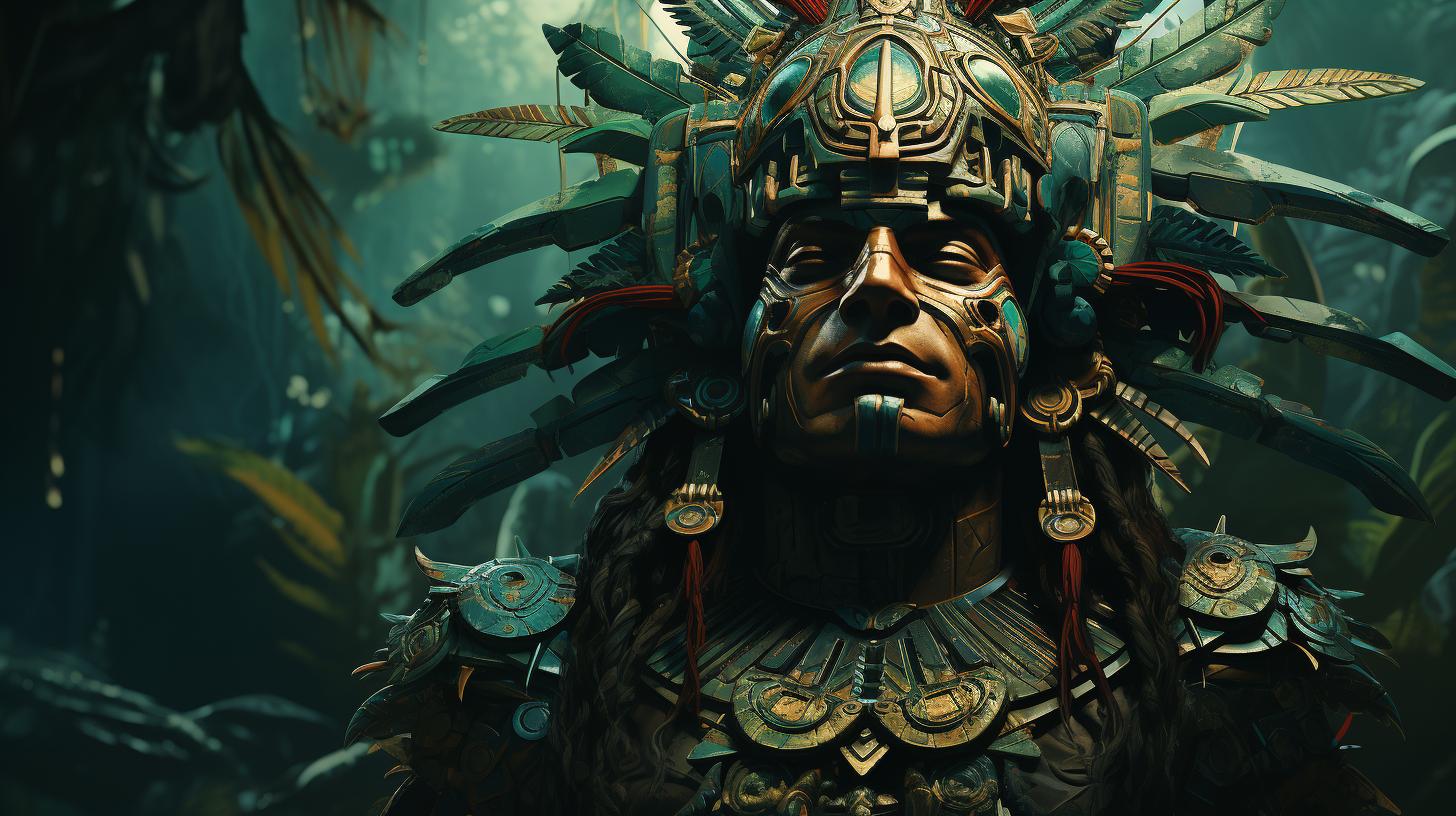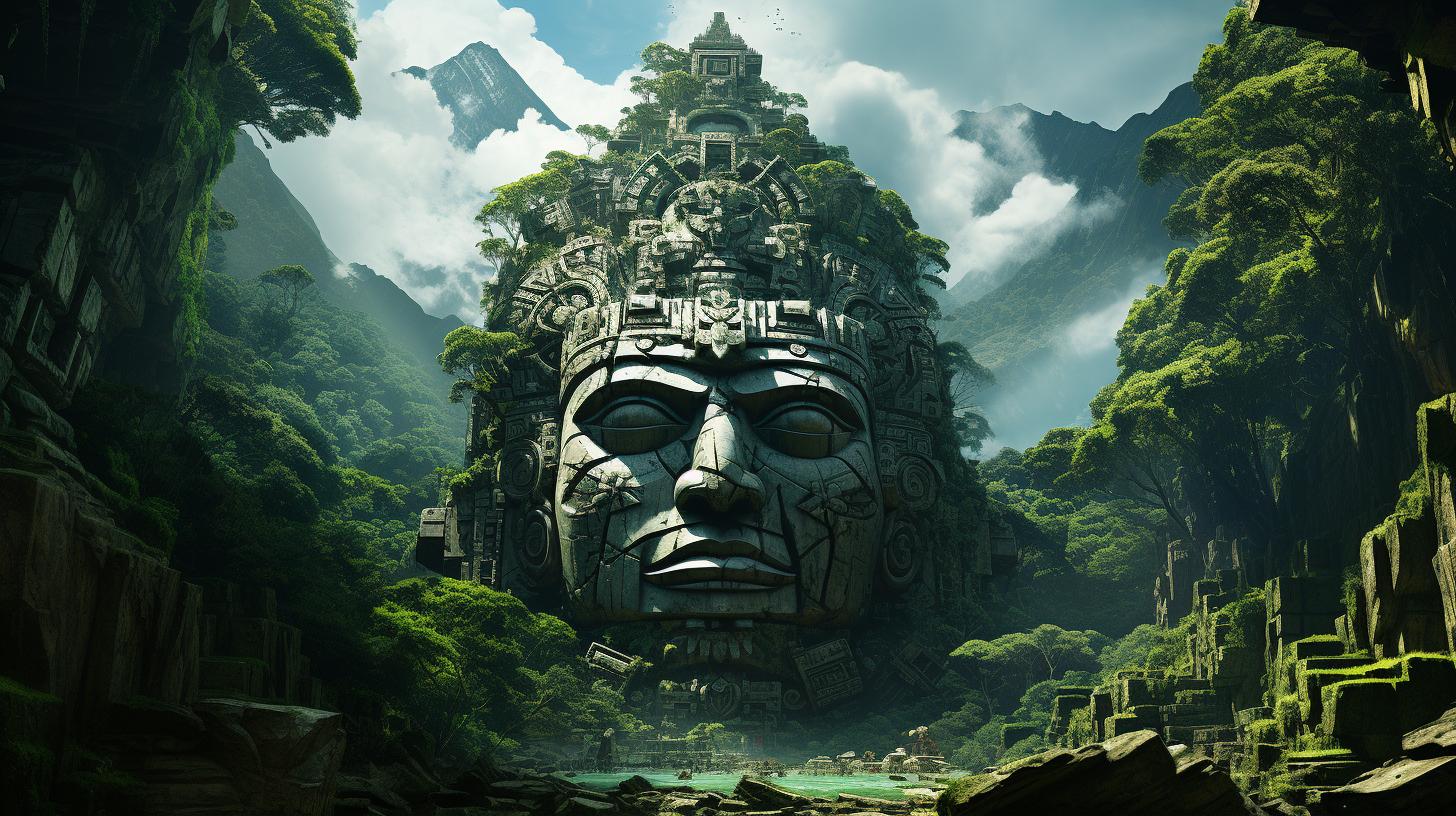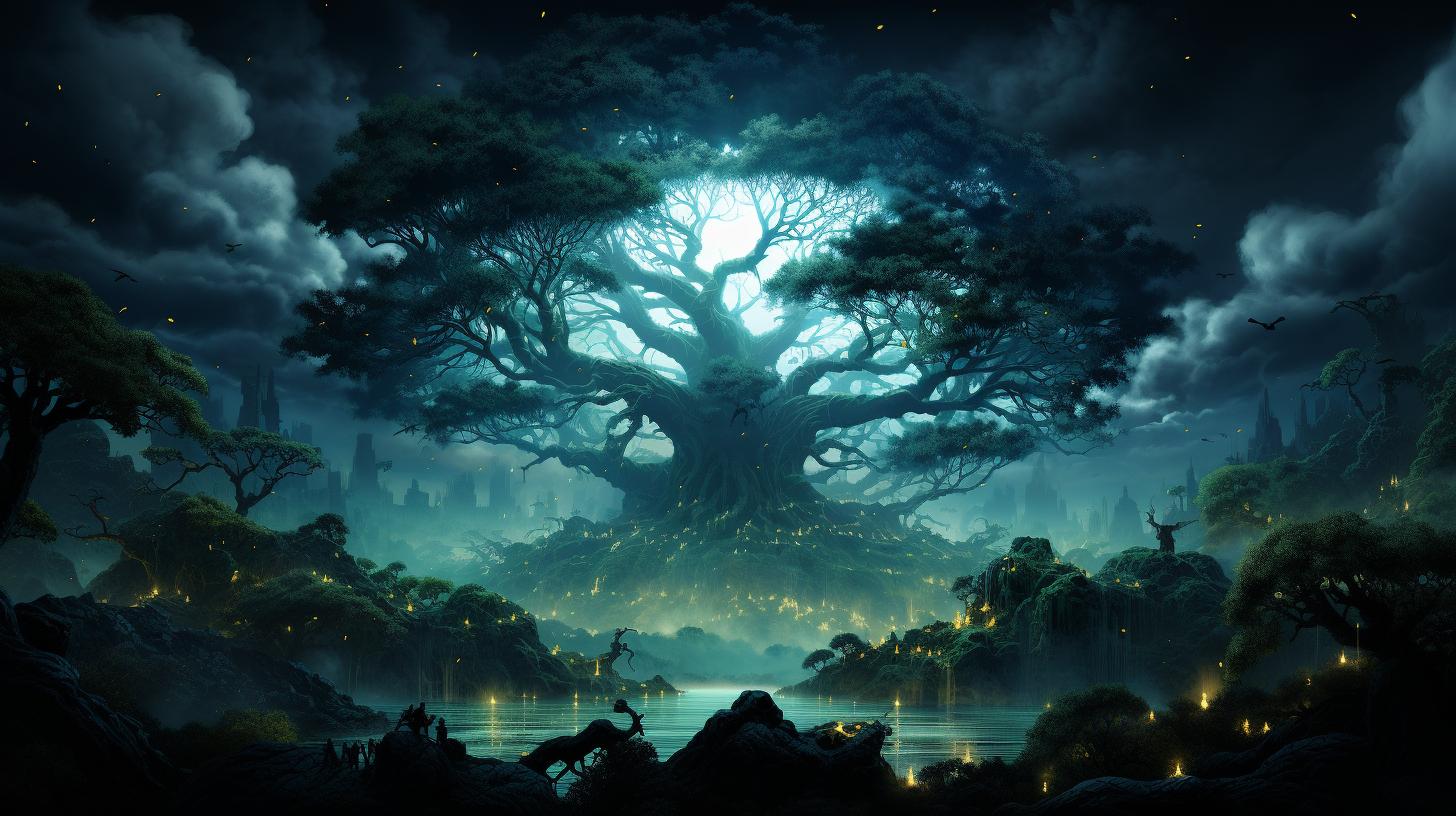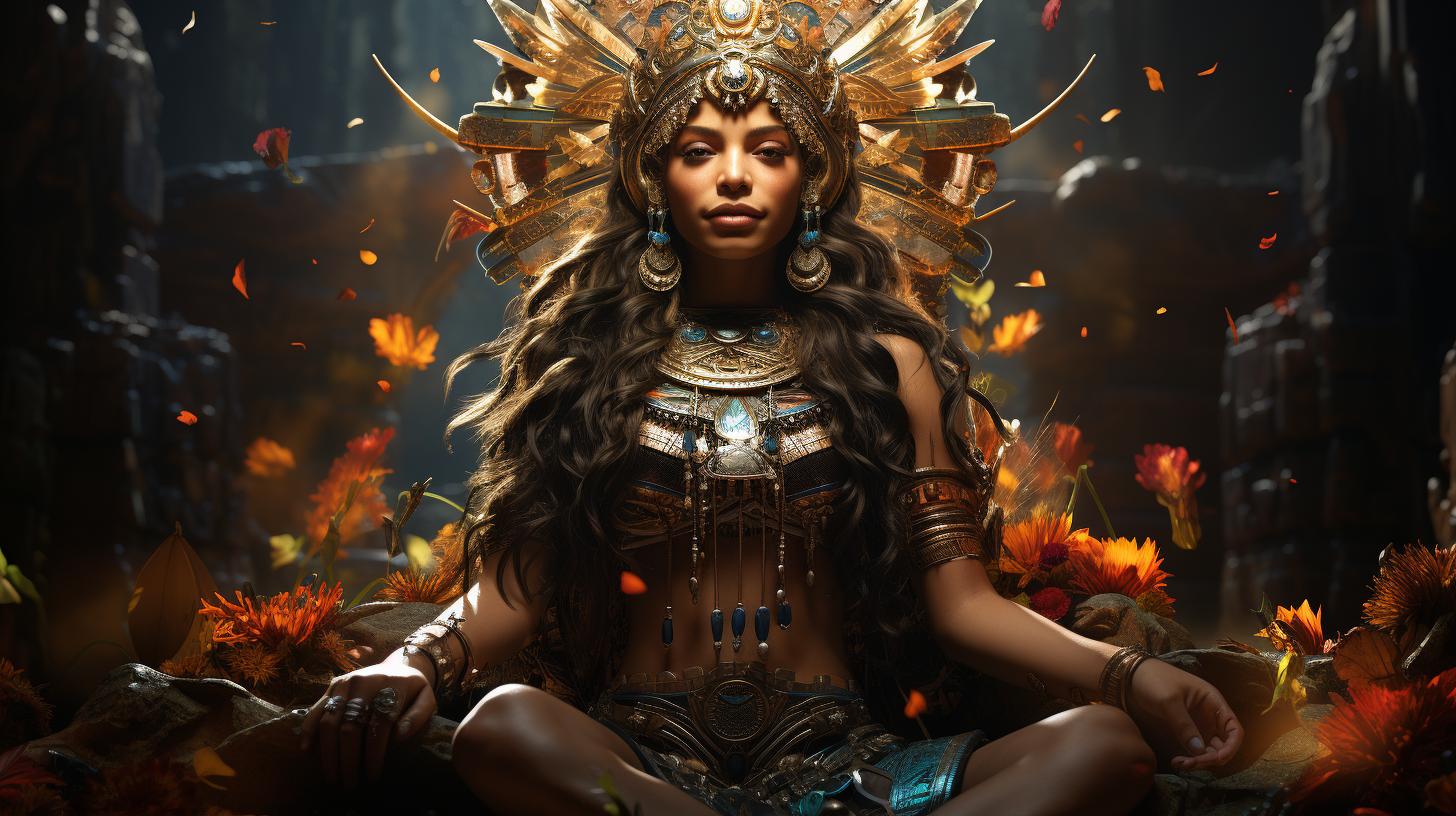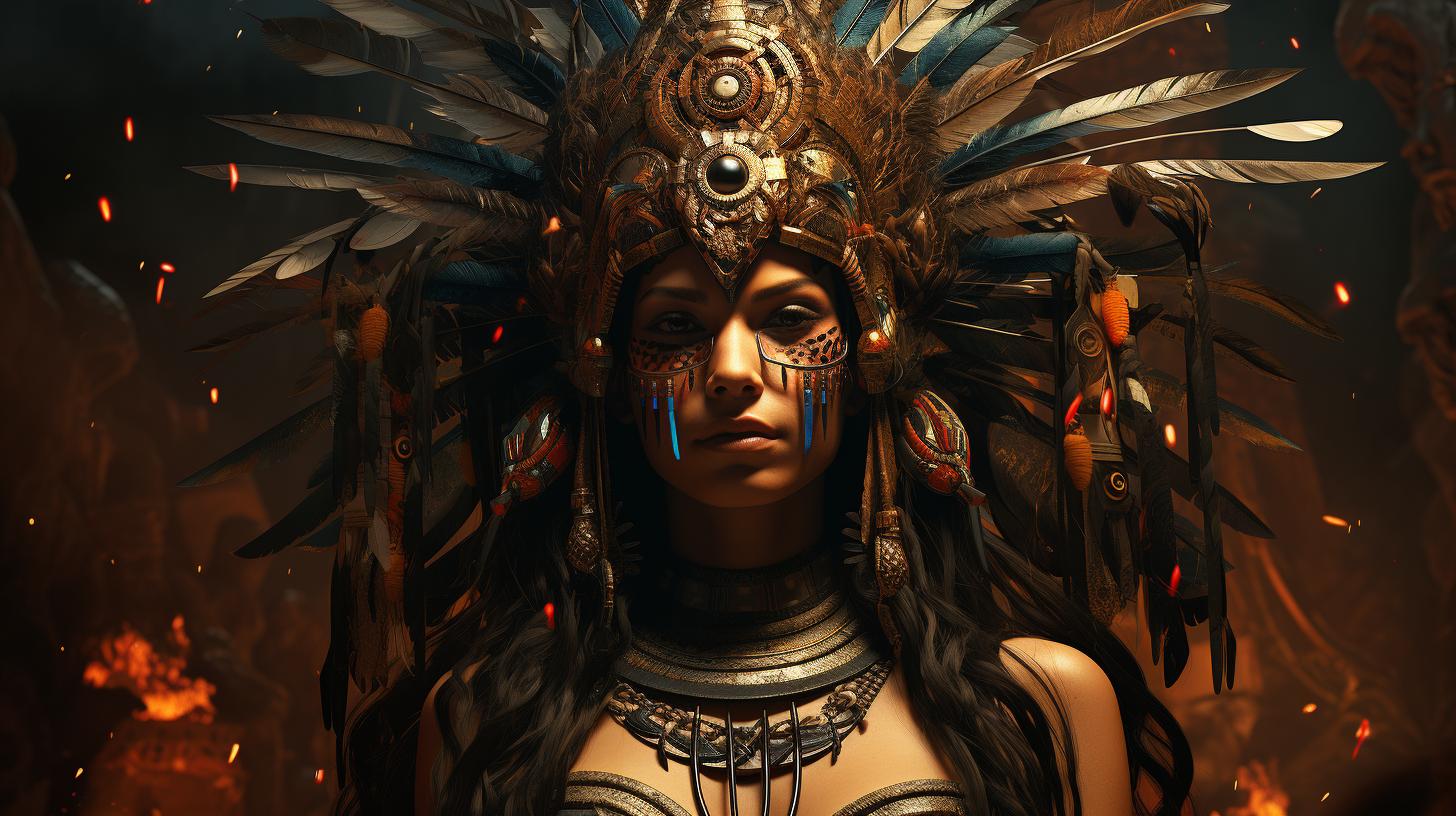Pawahtun: Unveiling the Mysteries of the Mayan God
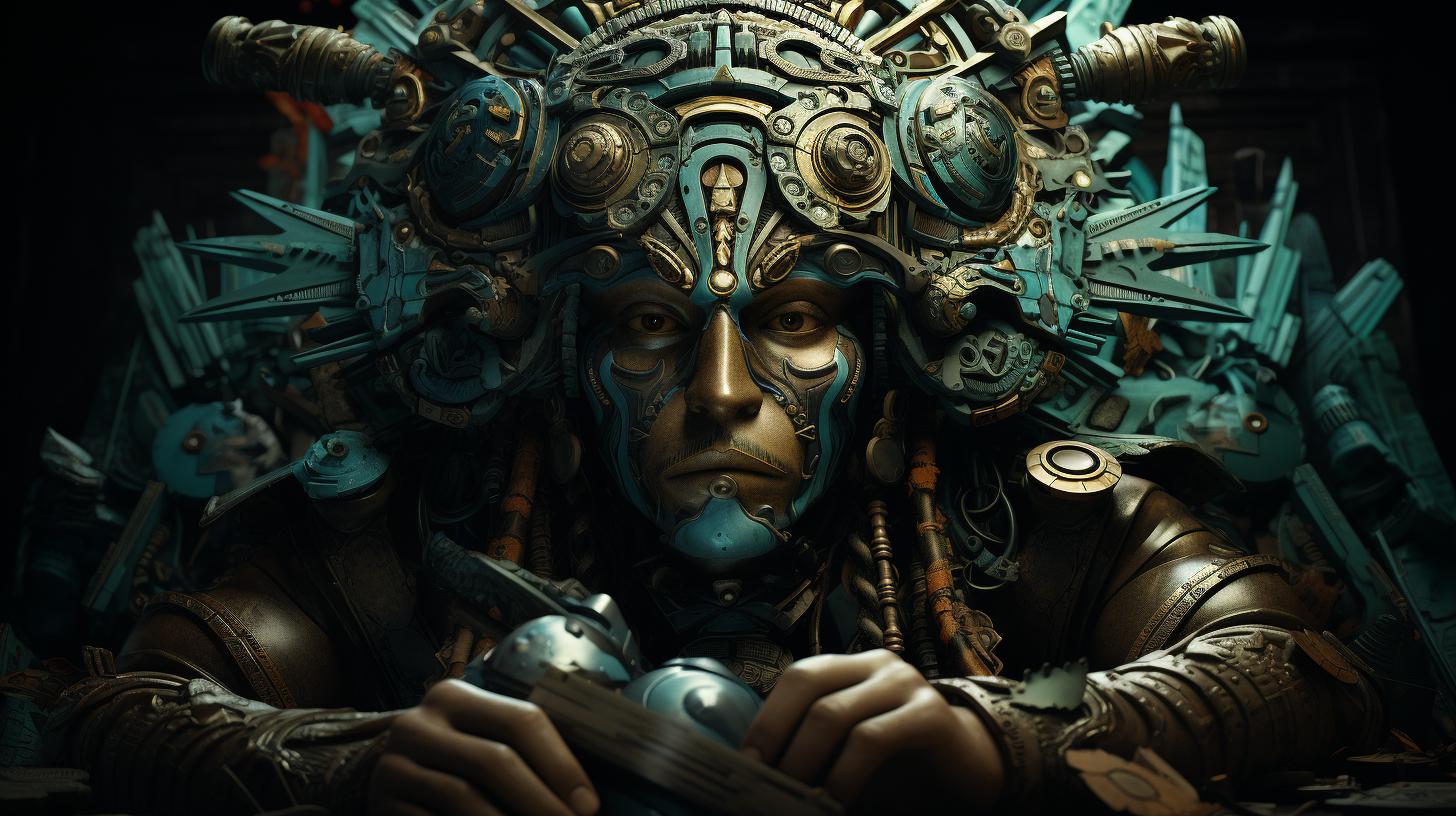
Pawahtun, the Mayan god, holds a prominent place in Mayan mythology. Represented as a quadrupartite deity, he has control over the four directions, colors, and pillars. His neutrality in terms of good and evil adds to his intriguing nature.
Pawahtun’s close association with the ancient Mayan nobility is evident through the symbolism of fish and water lilies in his headdress. This connection extends to various ancient cultures. Additionally, Pawahtun’s link to creation, celestial beings, and his role as the patron of Imix further deepens his significance.
The depictions of Pawahtun in ancient Mayan ruins and the presence of his representations in museums worldwide showcase his enduring legacy in Mayan culture.
Pawahtun: The Quadripartite Deity
Pawahtun, the Mayan god, is a fascinating and enigmatic figure in Mayan mythology. Represented as a quadrupartite deity, Pawahtun possesses the ability to control the four directions and colors, as well as the four pillars that uphold the heavens.
This unique depiction showcases his power and influence over various aspects of the cosmos.
Representation of Four Directions and Colors
Pawahtun’s representation as a deity capable of controlling the four directions speaks to his role as a guardian of balance and harmony in the Mayan cosmology. Each direction holds its own significance and symbolism, and Pawahtun’s influence over them suggests his role in maintaining order and equilibrium.
Similarly, Pawahtun’s dominion over the four colors further emphasizes his connection to the natural elements and the diverse aspects of the world. This association with colors highlights his role in the cycles of life, death, and rebirth that permeate Mayan beliefs.
Symbolism of the Four Pillars
The four pillars upheld by Pawahtun represent the foundations of the celestial realm. As the deity responsible for sustaining these pillars, Pawahtun ensures the stability and continuity of the heavens. This symbolism underscores his status as a powerful and essential figure in Mayan cosmogony.
Pawahtun’s Neutrality in Good and Evil
Pawahtun’s neutrality distinguishes him from many other gods in the Mayan pantheon. Unlike deities associated with specific aspects or forces, Pawahtun remains impartial, not aligning with notions of good or evil.
This neutrality positions him as an objective and unbiased arbiter, free from moral constraints and judgment.
His 5120 popularity index signifies the reverence and respect accorded to him, reflecting the Mayan people’s recognition of his importance and transcendence of dualistic concepts.
Pawahtun and Ancient Mayan Nobility
Connection between Pawahtun and Ancient Mayan Nobility
Pawahtun, the Mayan god, holds a significant connection with the ancient Mayan nobility. The representation of Pawahtun wearing a headdress depicting a fish biting a water lily symbolizes his association with Imix, the Crocodile.
Imix itself represents the ancient noble class, emphasizing the importance of Pawahtun in Mayan aristocracy.
Tocados and Symbolism of Fish and Water Lily
The distinctive headdress worn by Pawahtun showcases a fish biting a water lily, which holds symbolic meaning. The fish represents the abundance of aquatic resources, while the water lily symbolizes life, fertility, and the creation aspects associated with Pawahtun.
These symbols exemplify the connection between Pawahtun and the agricultural importance of water in Mayan society.
Comparative Analysis with Other Ancient Cultures
The symbolism of fish and water lily associated with Pawahtun can be found in various ancient cultures beyond the Maya. This includes the Sumerian, Babylonian, and Mesopotamian cultures, as well as ancestral tribes like the Chaldeans, Dogon, and Japanese.
The presence of amphibious beings in these cultures, such as the Nommo of the Dogon, further indicates the shared belief in ancient stellar beings influencing and ruling over the Earth.
Overall, Pawahtun’s connection with ancient Mayan nobility, as depicted in the headdress symbolism, reinforces his elevated status and influence within Mayan society.
The comparative analysis with other ancient cultures underlines the widespread presence of fish and water lily symbolism, signifying the cross-cultural significance of Pawahtun as a deity associated with creation, wisdom, and power.
Pawahtun and the Sacred Turtle
Exploring the deep symbolism and significance associated with Pawahtun’s connection to the sacred turtle in Mayan culture.
Significance of the Tortoise Shell
The tortoise shell holds immense importance in Mayan mythology, representing longevity, wisdom, and protection. It is believed to be a sacred object that bridges the gap between the celestial realm and the earthly realm.
Ac: The First Image of Creation
The constellation Ac, symbolizing the tortoise, is considered the first image created in Mayan mythology. This powerful symbol holds the phonetic value ‘ah’ in the Yucatec language, signifying both “dawn” and “creation.”
Its celestial origins and connection to the turtle reinforce its role in the creative narrative.
Celestial Origins and Earthly Connections
Pawahtun’s association with the sacred turtle showcases the cosmological beliefs of the ancient Maya. It suggests a belief in celestial beings who descended to Earth and played a role in the formation and governance of the world.
The turtle’s earthly presence, along with its celestial origins, reflects the interconnectedness of the spiritual and physical realms in Mayan cosmology.
Pawahtun as the Patron of Imix and Creation
Pawahtun, the quadripartite Mayan deity, holds a significant role as the patron of Imix, the first day in the Mayan calendar. This day, represented by the water lily glyph, encompasses profound symbolism associated with creation, the Earth, water, and abundance.
Imix: The First Day in the Maya Calendar
Imix marks the beginning of the Mayan calendar, symbolizing the primordial and foundational aspects of creation. As the patron of Imix, Pawahtun embodies the essence of this important day, representing the divine powers responsible for initiating the cosmic order.
Symbolism of Water Lily Glyph
The glyph of the water lily, closely connected to Pawahtun’s patronage, signifies the vital forces of life, fertility, and renewal. This glyph often appears in Mayan writings and carries multiple phonetic and symbolic meanings, reflecting the diverse aspects of Pawahtun’s influence.
Multiple Meanings and Significance
Pawahtun’s role as the patron of Imix and embodiment of the water lily glyph amplifies his association with creation, growth, and abundance in the Mayan belief system. The multiple meanings attributed to Pawahtun’s symbolism reinforce his importance and mysterious nature within the ancient Mayan cosmology.
Pawahtun in Ancient Maya Art and Ruins
Pawahtun’s presence and significance can be observed through various depictions in ancient Maya ruins, showcasing the enduring legacy of this deity in Mayan art and culture. These depictions provide valuable insights into the religious and spiritual beliefs of the ancient Maya civilization.
Depictions in Ancient Maya Ruins
Ancient Maya ruins serve as a treasure trove of artistic representations of Pawahtun. Stone carvings and sculptures found in temples, palaces, and other archaeological sites depict Pawahtun in various forms and contexts.
These intricate artworks reveal the reverence and importance given to this deity within the ancient Maya society.
Copán: Carvings of Pawahtun and Bacab
The archaeological site of Copán is particularly significant in understanding Pawahtun’s role in Mayan art. Carvings at Copán depict Pawahtun in conjunction with the Bacab, a group of deities associated with the cardinal directions.
These carvings symbolize the divine support and protection that Pawahtun and the Bacab provided to the Mayan civilization.
Representation of Wisdom and Knowledge
Beyond its association with the cardinal directions, Pawahtun’s imagery in ancient Maya art also highlights its connection to wisdom and knowledge. The portrayal of Pawahtun often includes attributes and symbols associated with wisdom, such as a regal demeanor and references to celestial knowledge.
These representations emphasize the deity’s role as a source of divine wisdom and guidance for the ancient Maya.
Sacred Artifacts and Representations of Pawahtun
Exploring the rich cultural heritage of the Mayans, the sacred artifacts and representations of Pawahtun provide valuable insights into their mythology and religious practices.
Diverse Artifacts Showcasing Mayan Mythology
The Mayans expressed their beliefs and reverence for Pawahtun through a variety of artifacts. Carved stone reliefs, intricate pottery, and elaborate sculptures depict scenes and symbols associated with this revered deity.
These artifacts offer a glimpse into the complex cosmology and religious traditions of the Mayan civilization.
Ceramics and Depictions of Maize God
Ceramics hold a special place among the sacred artifacts found in Mayan ruins. Intricately crafted vessels adorned with Pawahtun’s symbols and representations of the maize god connect the divine realm with everyday life.
These ceramic pieces act as conduits for spiritual rituals, serving as containers for offerings and embodying the power of Pawahtun.
Global Presence in Museums
The influence of Pawahtun extends beyond the ancient Mayan civilization, resonating with people worldwide. Museums around the globe house remarkable collections of Mayan artifacts, including representations of Pawahtun. These exhibits not only showcase the artistic achievements of the Mayans but also foster a deeper understanding of their spiritual beliefs and traditions.
- Carved stone reliefs, sculptures, and pottery depict scenes and symbols related to Pawahtun.
- Intricate ceramics with representations of the maize god serve as vessels for spiritual rituals.
- Museums worldwide exhibit Mayan artifacts, providing insights into Mayan mythology and culture.
By studying these sacred artifacts and representations, we gain a profound appreciation for the intricate worldview of the Mayans and their deep connection to Pawahtun.
These tangible remnants of ancient beliefs continue to captivate and inspire awe, allowing us to delve into the mystical realms of Mayan mythology.
Exploring the Significance of Pawahtun in Mayan Culture
Pawahtun, the Mayan god, holds immense significance within Mayan culture.
Let’s delve into the various aspects that underscore the importance of Pawahtun in Mayan society.
Pawahtun’s Connection to Creation and Cosmic Beings
Pawahtun’s association with creation is paramount. As the patron of Imix, the first day in the Maya calendar, Pawahtun symbolizes new beginnings, the Earth, water, and abundance. The water lily glyph frequently used to represent Imix further reinforces these concepts.
His connection to celestial beings extends beyond Mayan culture, with similarities found in ancient Sumerian, Babylonian, Mesopotamian, Chaldean, Dogon, and Japanese cultures.
Influence on Rulers and Religious Practices
Pawahtun’s influence on rulers and religious practices cannot be overstated. In ancient Mayan society, Pawahtun was closely associated with the nobility and played a central role in their rituals and ceremonies.
His representation in consorts and regalia emphasized the noble lineage and the divine connection to power. Pawahtun’s neutrality, being neither good nor evil, allowed rulers to align themselves with his unbiased and balanced energy.
Furthermore, Pawahtun’s strong ties to the concha de tortuga, the sacred turtle shell, highlight his significance in Mayan religious beliefs. The tortoise shell, represented by the Ac constellation, is considered the first image of creation.
Its phonetic value ‘ah’ meaning ‘dawn’ and ‘create’ in the Yucatec language signifies the celestial origins of the tortoise shell and its earthly associations.
Impact and Legacy in Ancient Mayan Society
Pawahtun’s impact and legacy can be witnessed through various artifacts and representations found in ancient Mayan ruins.
From Copán’s stone carvings depicting Pawahtun and Bacab upholding the four corners of the universe to sacred ceramics displaying the maize god dressed as Pawahtun, these artifacts exemplify the deep-rooted belief in the power and significance of Pawahtun.
Moreover, the global presence of Pawahtun in museums worldwide showcases the enduring legacy and importance of this Mayan god. These representations serve as a testament to the rich and diverse mythology that shaped Mayan culture and religion.
Through exploring the multifaceted significance of Pawahtun in Mayan culture – his connection to creation and cosmic beings, influence on rulers and religious practices, and enduring impact on ancient Mayan society – we gain a deeper understanding of the complex and awe-inspiring world of Mayan mythology.
.

